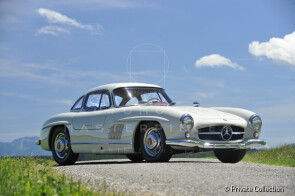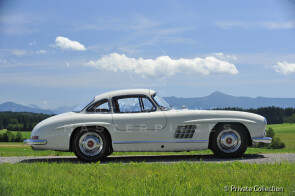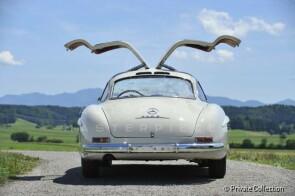
1955 Mercedes-Benz 300 SL
ON/OFF
Why am I an Automotive Masterpiece?
Whilst Mercedes-Benz initially had no plans for series production of its racing (W194) 300 SL, its U.S. importer, Max Hoffman, had other ideas. Hoffman, a master marketer and a man of great insight, persuaded Daimler-Benz AG to offer a production model by ordering 1,000 of them to be sold in the United States. The idea was of a toned-down Grand Prix car, tailored to performance enthusiasts in the booming post-war American market. The new (W198) 300 SL, introduced at the 1954 New York Auto Show rather than the usual Frankfurt or Geneva shows, was both a grand tourer and the fastest production car of its days. This is the first of all the SL Mercedes Benz, where SL stands for Sport Leicht (Sport Light). It was built around an innovative aluminum tube spaceframe chassis, designed by engineer Rudolf Uhlenhaut, that saved weight while providing a high level of strength. Since it enveloped the passenger compartment, traditional doors were impossible, giving birth to the model's distinctive gull-wing arrangement. After a handful of early production models were made in alloy, as the competition cars were, the new Karl Wilfert and Friederich Geiger-designed body was largely steel, retaining aluminum doors, hood, and boot lids, and included the bumpers (with over-riders for U.S.-spec cars) and numerous comforts, including a tilt-wheel for ease of entry and featuring a sumptuous interior that is a requisite for Mercedes-Benz owners road use. Only 29 cars had an aluminum body designed for competitions, which for the 300 SL W198 were reserved for private drivers. For the engineering, the designers had to fight a lot to combine innovative ideas and performance needs with the difficult situation of German car builders right after the war, due to the rules and to economic conditions. A Bosch mechanical Fuel Injection replaced the race car’s carburetors: the unit, derived from the one used on the Messerschmitt fighter of World War II, on suggestion by Hans Scherenberg, a Daimler-Benz Avio engineer, raised the power output and would be the first for a production car. Like the W194, anyway, the W198 borrowed its 3.0 litre OHC straight-6 largely from the four-door 300 (W189), the famed "Adenauer" luxury tourer. Featuring an innovative aluminum head, with dry-sump lubrication, the engine was inclined to the side in order to reduce the height of the front end. The power, rated at 215 brake horsepower at 5,800 rpm (DIN) with the factory-optional or dealer-installed “sport” camshaft, was delivered through a four-speed manual gearbox. A 161 mph top speed and 0–60 acceleration of approximately eight seconds, depending upon the rear-end ratio selected from five options, made the 300 SL the fastest production automobile of its time. Aerodynamics played an important role in the car's speed, with Mercedes-Benz engineers placing horizontal "eyebrows" over the wheel openings to reduce drag. At high speed the car wasn’t easy to manage with the series-derived swing-axle rear suspension, nevertheless the W198 was an absolute winner when raced, beginning with the 1955 Mille Miglia, where was winner in class. With the 300SL, Daimler-Benz AG reaffirmed its prestige in those areas that had made it famous in the pre-war period, namely the class and elegance of its cars, but also their weight in sporting competition. Immediately successful and today iconic, when production ended after the 1957 model year, Hoffman’s original request for 1,000 cars was exceeded, as the production reached just 1,400 units. More than 80% of the vehicle's total production were sold in the U.S., making the Gullwing the first Mercedes-Benz widely successful outside its home market. In 1957 the 300SL began a new life as a roadster (W198 II), but this is another story.
Chassis no. 1980405500611 is a very special Gullwing. Ordered new by Munich architect and artist Bert Linke-Wachwitz (1908-1985), it was specified with understated DB158 ‘white grey’ paintwork and red leather upholstery piped in black, rarely found on a Gullwing. The driver’s seat cushion was slightly higher, two fitted suitcases were requested, and the wheel hub cap centres painted red to match the cockpit trim. The combination of these features makes for a particularly striking and handsome motorcar. Following delivery on 12th August 1955, and according to the authoritative Gullwing Group Register, the car later passed to another Munich resident, Gunther Moritz, before importation to the warmer climate of Brea, California, in 1966. The next owner was Gerald Earnest Hansen of North Hollywood, before the car returned to Europe in the hands of Claes Goran Hammergren of Boras, Sweden, before the current private owner. Perhaps most remarkable is how almost 60 years after delivery to Mr Linke-Wachwitz, his distinctive Gullwing has never been restored.




